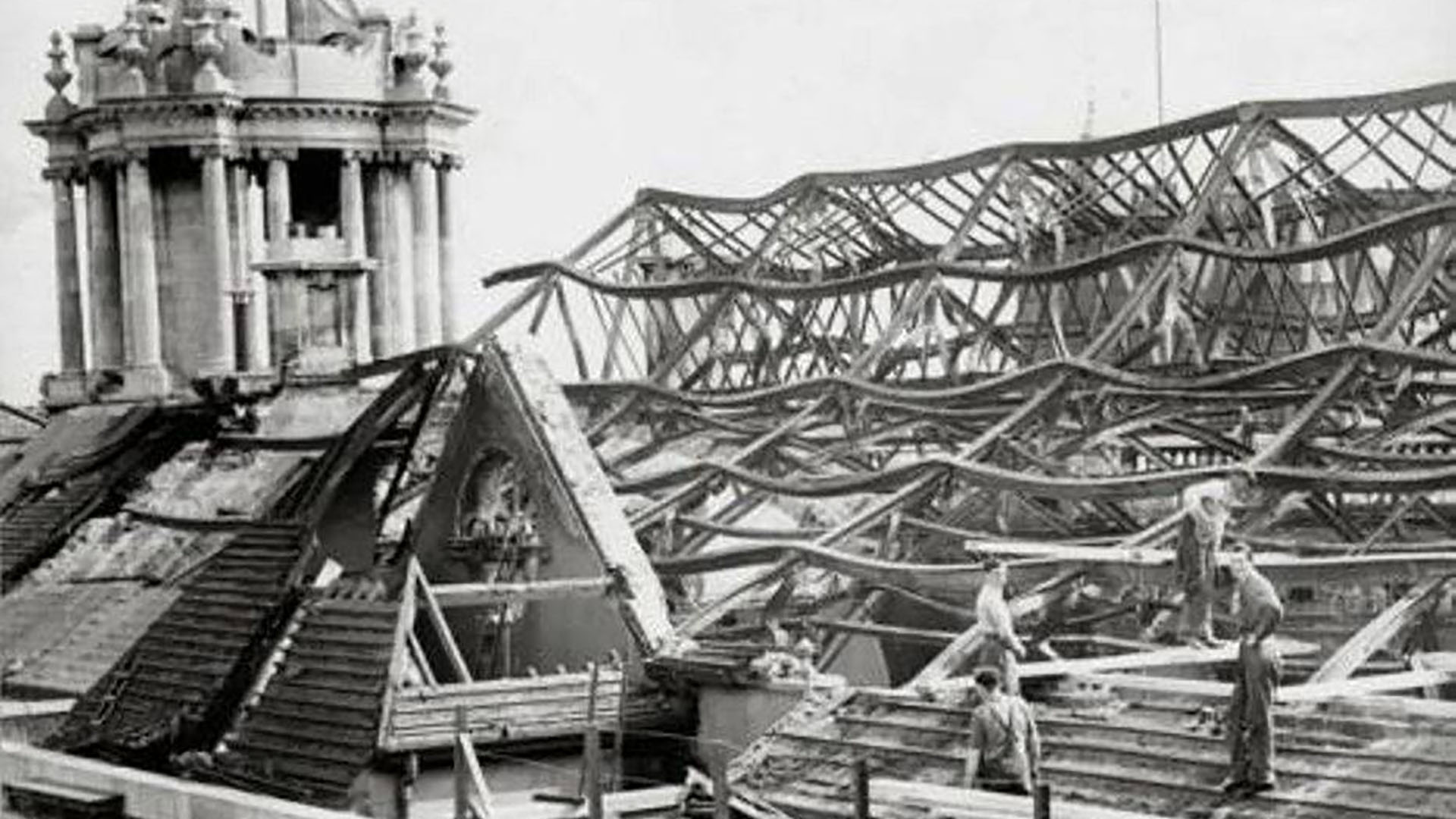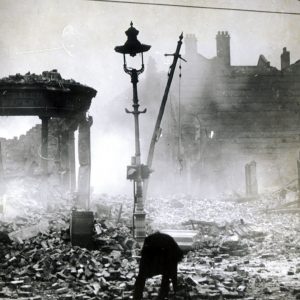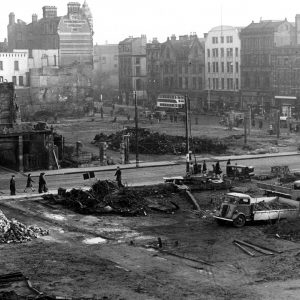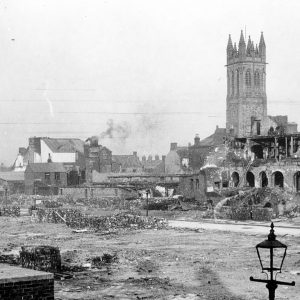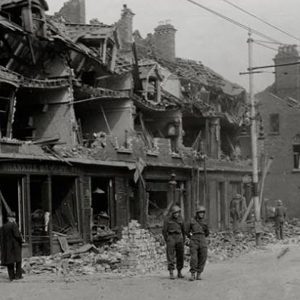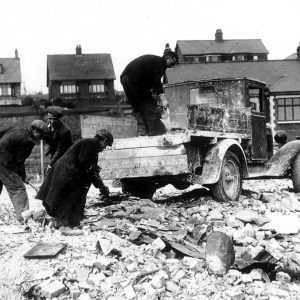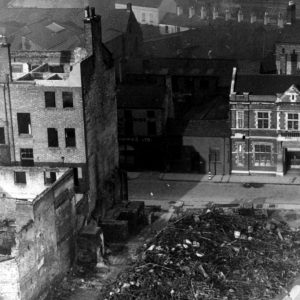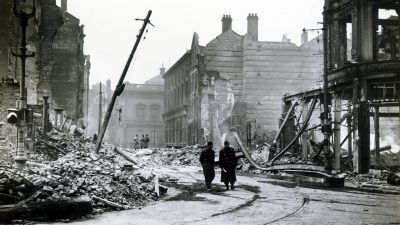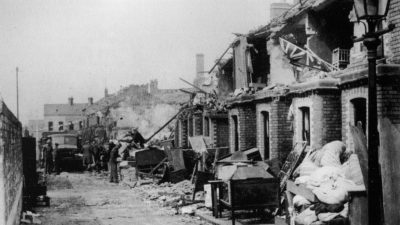In April and May 1941, the Luftwaffe attacked Belfast in a series of 4 raids that became known as the Belfast Blitz. The Fire Raid occurred on the night of 4th-5th May 1941 when over 100,000 high explosive bombs and incendiaries fell on the city.
At 2345hrs on Sunday 4th May 1941, air raid sirens sounded throughout the city. At 0010hrs, Air Raid Wardens sounded the red alert. Anti-aircraft gunners stood by their weapons in anticipation. By 0047hrs, radar operators plotted incoming planes. Soon, the people of Belfast heard the hum of approaching Heinkel and Junkers planes.
Timeline of the Raid
5th May 1941 – 0107hrs
Around 200 Luftwaffe planes filled the sky, flying in over the Co. Down coastline under the light of a full moon. The bombers came in in 2 formations. The first passed over the Copeland Islands towards Carrickfergus, Co. Antrim. From there, they followed the northern shore of Belfast Lough. A second formation swooped over the east coast over Carlingford Lough, Rostrevor, Hilltown, and Dromara.
An Elite Pathfinder Squadron of Luftwaffe bombers flew over East Belfast at 0107hrs on Monday 5th May 1941. The target; Queen’s Island, the docks and Belfast’s shipyards. In the first hour of the attack, over 6,000 incendiaries fell in this area. Fires spread and helped to guide in following bombers. Attackers came in between 9,000 and 13,000 feet.
Musgrave Dock and Dufferin Dock, Belfast sustained heavy damage. A group of 3 small Corvettes neared completion in the docks area. All sank, a 4th burned in the water, and 4 more sustained damage. The Fairhead, a transport ship, sank at its mooring. The Harland and Wolff Shipyard Ltd. lost two thirds of their premises including workshops, offices, and sheds. For the next 3 months, Short and Harland aircraft production ceased. In the docks area, The Oval football ground sustained heavy damage causing the team to relocate for many years.
5th May 1941 – 0200hrs
Within 60 minutes of the first bombs falling, fires raged through East Belfast, North Belfast, and the City Centre. With fires beyond the resources of local firefighters, help once again arrived from Ireland. Belfast crews suffered from a lack of appliances and equipment. Water level at low tide and damage caused to the Waterworks during The Easter Raid did not help the situation. On this occasion, there was no invite required for assistance from Eire. When Irish firefighters arrived, they received food. ARP Wardens directed them to the hardest hit areas of the city.
A further 6 crews arrived from Co. Londonderry. On the way over the Glenshane Pass, Charlie Gallagher stopped his appliance to allow the engine to cool. There, 45 miles north of the capital city, he saw fires pulsating into the night sky.
5th May 1941 – 0230hrs
Abercorn Yard, Queen’s Yard, Clarence Works, Alexandra Works, and the Victoria Shipyard burned. Thousands more incendiaries fell across East Belfast. Residential areas around the Lower Newtownards Road became engulfed in flames while a shelter at Memel Street took a direct hit. There were no survivors in the shelter. Rescue teams and dockers dug through rubble for a week before recovering the first of 13 bodies. Nearby, in Avondale Street, Belfast, 25 people died when another shelter took a hit from a high explosive bomb. Streets like Witham Street were almost wiped from the map with 35 houses destroyed.
In the City Centre, fires raged around St. Anne’s Cathedral although the church itself survived. High Street burned from the Bridge Street as far as the Albert Memorial Clock and Belfast’s Victorian City Hall suffered damage to the banqueting hall. Across the city, buildings such as Arnott’s Stores, Athletic Stores, Bank Buildings, Co-Op Buildings, Dunville’s Sores, Gallahers’ Factory, Rosemary Street Presbyterian Church, St. George’s Church, Thornton’s, Ulster Arcade, Water Commissioners’ Offices, and York Street Mill burned into the early morning.
In North Belfast, around 300 women and children sheltered in the crypt beneath Clonard Monastery on Falls Road, Belfast. Those seeking shelter came from both the mainly Nationalist Falls Road and the mainly Unionist Shankill Road. They sang hymns and recited prayers as bombs devastated the city.
5th May 1941 – 0425hrs
By the time the all-clear sounded at 0425hrs, around 200 buildings burned throughout Belfast. Over 203 metric tonnes of high explosives, 80 parachute mines, and 800 firebombs canisters hit the city that night. The canisters contained over 96,000 incendiary bombs. By dawn, the enemy planes had gone but the fires continued to burn.
Aftermath of the Fire Raid
Following the raid, the Belfast Telegraph commented on the extensive damage to the city. Reports suggested that residents who lived all their lives in Belfast lot their way the day following the raid. On that day, Voluntary Aid Detachment nurse Emma Duffin noted in her diary:
The smell of burning was in the air. The grass was strewn with blackened and charred papers. There was a sheet from a child’s essay book. On the top of the page I read “The End of the World”. It seemed appropriate. It was the end of the world as we knew it.
Reaction to the Raid
Around 150 people died in Belfast during The Fire Raid. A further 157 people sustained serious injuries. Reasons for this included better advanced warnings and the bombers approaching from a greater height. The attack occurred later on a Sunday night and more bomb fell on the docks than on residential areas.
Still, the Northern Ireland government struggled with the realities of the situation. A cabinet meeting shortly after the May fire raid saw an offer of power from the Eire Electricity Board turned down. The cabinet cited “political difficulties of making any such arrangement”. For the first and only time during the Second World War, Belfast made the headlines in the German press. It laid out in detail the devastation of major industries and destruction of the shipyards.
Belfast would not suffer such a night of Luftwaffe bombing again during the war. Instructions from Joseph Goebbels suggested that further attacks may provoke Irish American politicians. The Nazis did not want the United States of America to enter the war. Within the following year, however, America entered the war and by May 1942, thousands of US Army troops had arrived in Northern Ireland.
